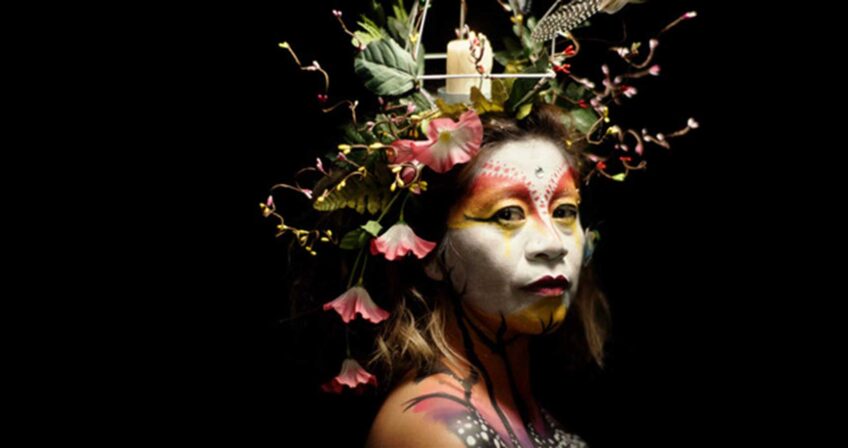‘Black Radical Women’ exhibit on view at ICA
‘We Wanted a Revolution’

Some art exhibitions demand and reward multiple visits. One such show is “We Wanted a Revolution: Black Radical Women, 1965–85,” on view through Sept. 30 at the Institute of Contemporary Art/Boston.
Contrary to its title, the works on view, from about 40 African American women, include many with compelling immediacy.
Take “Target” (1970), a sculpted bronze head of a black man caught in the crosshairs of a riflescope, crafted by Elizabeth Catlett (1915-2012) after Chicago police shot Black Panther activists. Also small but potent is the 18-inch sculpture by Betye Saar, “Liberation of Aunt Jemima: Cocktail” (1973), which turns a jug labeled with the clichéd face of a mammy into a Molotov cocktail.
And the commanding 8-by-8-foot oil painting by Faith Ringgold, “For the Women’s House” (1971), is both inspiring and prophetic in its exhilarating images of women in roles formerly reserved by men — driving a bus, running the country, scoring for the Knicks — as well as teaching and raising children.
What most of the objects on view have in common is their dual power to exist as works of art — prints, sculptures, paintings, and videos with magnetism to captivate viewers — and also to bear witness to truths about our daily lives and the state of society.
All the works speak to the ongoing struggle of African American women to claim their place in an art world and society dominated by those unlike themselves. That they succeeded is evident both in the caliber of the show and the prominence of so many black women artists today. Yet the movement of self-determination this exhibition presents is as necessary now as it was in the ’80s.
In the archives
Originally co-curated by Catherine Morris and Rujeko Hockley for the Brooklyn Museum, the exhibition includes a substantial amount of archival material — newspaper articles, correspondence, manifestos — that tracks the evolution of a movement that gained momentum with the efforts of groups as well as individual artists. This material can make for revelatory study to history-minded viewers interested in the stops, starts and resilience of a ground-up movement that was propelled by the vision and spirit of artists who were, by and large, young, chic, smart, gifted urbanistas.
The curators carry their exploration of this productive interplay of art with a quest for self-determination into two books that are as vibrant as the exhibition. In “We Wanted a Revolution: Black Radical Women, 1965-85/A Sourcebook,” participating artists and writers reflect on the movement’s milestones. Morris and Hockley also co-edited “We Wanted a Revolution: Black Radical Women, 1965-85/New Perspectives,” which presents contemporary takes on the movement’s legacies. Contributors include playwright and essayist Lisa Jones, a co-founder of the Rodeo Caldonia High-Fidelity Performance Theater, an 1980s Brooklyn collective that drew standing-room-only audiences with their sensational satirical reviews on race and sexism. A video of one performance, “Combination Skin,” is on view in the exhibition.
As visitors enter the first gallery at the ICA, they hear the soundtrack of a nearby video installation, “Arthur Jafa: Love Is the Message, The Message is Death.” The seven-minute sampling of triumphs and traumas drawn from African American life unfolds to Kanye West’s stirring, gospel-inspired song “Ultralight Beam.”
Pioneers
Here and in other galleries, the exhibition presents works by lesser-known artists alongside those with established reputations. Among the appealing artists not often seen in major shows is Dindga McCannon, whose painting “Empress Akweke” (1975), is an exuberant portrait of fellow artist Akweke Singho, which celebrates in a European modernist style the African heritage displayed by her friend’s attire.
Painter, printmaker and weaver Emma Amos held her first solo exhibition in Atlanta in 1960. That same year she moved to New York, where she became the first female member of Spiral, a group of black artists that included Romare Bearden. Amos’ splendid oil painting “Sandy and Her Husband” (1973), shows a couple dancing in their living room, decades before renowned artist Kerry James Marshall became known for introducing positive scenes of African American home life into major art galleries.
Among the better-known women presented in this show is Lorraine O’Grady, who made breaking into the white male art world a form of performance art. On view is her costume, fashioned from 180 pairs of white gloves. O’Grady wore the gown in her early-80s interventions, when, as “Mlle. Bourgeoise Noire,” she crashed New York gallery events carrying a cat-o-nine-tails and accompanied by her own PR person.
Haunting satires
Satire is a time-honored tool for channeling indignation and anger, and small-scale works can be as potent as large images. In the manner of Joseph Cornell (1903-1972), who turned tiny cabinets of evocative objects into theaters of memory and imagination, Janet Henry compresses her wry observations on race and social class into terse, witty compositions of tiny objects. One, entitled “Juju Box for a White Protestant Male” (1979-80), is an assemblage of rowing oars, a cable-knit sweater and other preppy paraphernalia.
For many, this exhibition will be an introduction to dancer and choreographer Blondell Cummings (1944-2015). Her 15-minute video, a solo dance performance entitled “Chicken Soup” (1981), will be reason enough for return visits. With fluent physical acting and soaring limbs, Cummings concocts a vision of her grandmother at work in the kitchen, scrubbing the floor and sliding and swirling with a frying pan in hand. Designated an American masterpiece by the National Endowment for the Arts in 2006, “Chicken Soup” easily rivals the Arthur Jafa/Kayne West video in its power to linger in a viewer’s mind and heart.






